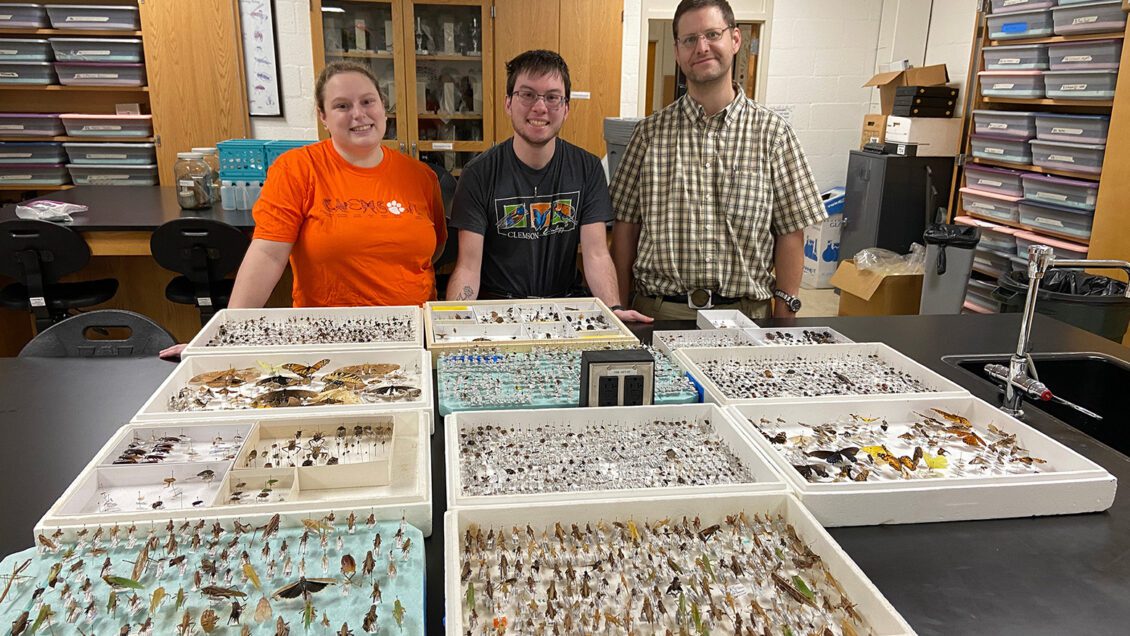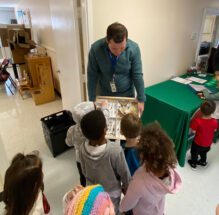
We use the museum to educate about how insects are an important part of our ecosystem.
STEPHANIE HOWARD
DIRECTOR OF THE PICKENS COUNTY LIBRARY SYSTEM
Insects are vital for the Earth’s environment and Clemson University entomology students are on a mission to teach others the importance of protecting these critters.
To help teach public school students in Pre-K through 5th grade about insects, Clemson students have designed miniature museums, lesson plans and fact sheets teachers can use for classroom instruction.
The mini museums include 100 specimens of beneficial insects, pests, invasive species and more, housed in 3-inch by 19-inch by 16.5-inch drawers. The model museum was designed by Clemson doctoral students Patricia Wooden and Adam Haberski, with Michael Ferro, collection manager for the Clemson Arthropod Museum.
“Before the COVID-19 pandemic, we were presenting information to schools and organizations in person,” said Wooden, Clemson Entomology Club outreach coordinator and past president, from Gloucester, Virginia. “After the pandemic limited our ability to provide this outreach to the public, we designed mini museums and fact sheets for teachers to use in their classrooms.”
The fact sheets are created by museum staff and students. They are designed by Niko Artley, a junior in Environmental and Natural Resources from Brookfield, Wisconsin, who volunteers for the program. Information from the Clemson Cooperative Extension Service is also used.
“In the Fall 2023 semester, students in Entomology 3010 Insect Biodiversity were given an assignment to research and create a fact sheet,” Wooden said. “All references, including image credits, are cited on the back of each fact sheet. Teachers can use information from the fact sheets in their lesson plans.”
Ordering miniature museums
Thanks to sponsors, including the Entomological Society of America Chrysalis Fund and the South Carolina Entomological Society, the mini museums and accompanying materials are free to all South Carolina public schools and libraries.
To apply, email
Michael Ferro at mferro@clemson.edu, or
Patricia Wooden at pwooden@clemson.edu.
Applicants are asked to include in their email the grade levels they teach and how the mini museum will benefit their programs.
The Pickens County Library in Easley, South Carolina, is home to one mini museum. Stephanie Howard, director of the Pickens County Library System, said the museum is popular with patrons.
“Adults think the museum is just as cool as the kids do,” Howard said. “We use the museum to educate about how insects are an important part of our ecosystem. We also use it to teach people how to identify insects. In addition, we try to dispel the myth that ‘bugs are gross.’ We want people to understand that insects are interesting and important.”
Jennifer Ward and her son Jackson attended an event where Ethan Cashwell of the Pickens County Library System talked with Pre-K students about insects in the mini museum. Ward said her son has always been interested in insects.

“He got a bug catcher with a magnifying glass for Christmas,” Ward said. “He also has a mesh ‘Critter Catcher.’ There’s not a bug he doesn’t like. In fact, his first word probably was ‘butterfly.’ I appreciate him being exposed to educational materials such as this.”
Jennifer Trotter teaches 5th grade at Six Mile Elementary School. She ordered a drawer to use when she teaches an ecosystems unit to her class. She also plans to share it with other teachers at her school.
“My students were amazed to see all of the insects in the drawer — there are a great variety of species.” Trotter said. “The insects are so cool and interesting and this led to all sorts of great questions from the students.”
Thanks to sponsors, including the Entomological Society of America Chrysalis Fund and the South Carolina Entomological Society, the mini museums and accompanying materials are free to all South Carolina public schools and libraries.
Currently, there are 25-funded mini museums. The materials for specimen drawers cost $100 each. Additional materials, such as binders and printed information, are $5 per drawer when purchased in bulk.
Organizations or individuals who want to donate money for a package can visit https://bit.ly/CU_MiniMuseums. For questions, email Michael Ferro at mferro@clemson.edu, Michael Caterino, Clemson Arthropod curator, mcateri@clemson.edu, or Patricia Wooden at pwooden@clemson.edu.
With guidance from faculty and staff, this project is managed by Clemson students. In addition to Wooden, Artley and students who developed the fact sheets, Curt Harden, a doctoral student and Clemson Entomology Club treasurer from Danville, Virginia, is also involved in the project. Former master’s student Caitlin Silva from Greencastle, Pennsylvania, was involved in the project before she graduated in Spring 2023.
Sponsor information
Each specimen drawer costs $100. Additional materials, such as binders and printed information, are $5 per drawer when purchased in bulk.
Donations for packages can be made at
https://bit.ly/CU_MiniMuseums.
For questions, email Michael Ferro at mferro@clemson.edu,
Michael Caterino, Clemson Arthropod curator, mcateri@clemson.edu, or
Patricia Wooden at pwooden@clemson.edu.
-END-




Captions
Left picture – Each miniature museum designed by Clemson students includes a specimen drawer of insects native to South Carolina, binders of information and printed information.
Upper right picture – Izzy Walton, 3, gets a lesson about insects from Ethan Cashwell during a visit to the Pickens County Library in Easley, SC.
Middle right picture – Ethan Cashwell of the Pickens County Library System talks with a Pre-K student about insects on display in a miniature museum designed by Clemson students.
Lower right picture – Each miniature museum contains about 100 specimens of insects native to South Carolina. The mini museums are created by Clemson University students.
Share information
Organizations with resources – such as 4H information, contact information for grants teachers can apply for and so on – to share in museum materials can contact:
Michael Ferro at mferro@clemson.edu,
Michael Caterino, Clemson Arthropod curator, mcateri@clemson.edu,
or
Patricia Wooden at pwooden@clemson.edu.
A section is provided in the binder just for resources.
Get in touch and we will connect you with the author or another expert.
Or email us at news@clemson.edu
